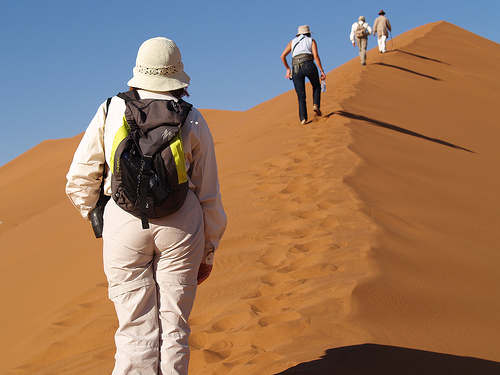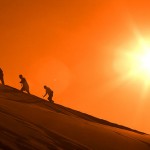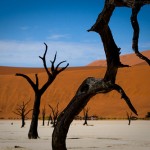Sossusvlei Desert of Namibia is best known for its extraordinarily large, towering red sand dunes. That of course after the fact that Sossusvlei is also the oldest and one of the driest deserts in the world. The only source of water is the Tsauchab River that only flows once every 10 years. Even though the dunes of the Sossusvlei are known for being some of world’s most impressive desert formations that will deliver the awe at any time of the day, in order to get the most breathtaking views, it is recommended to appreciate the sights during the sunrise and sunset hours, with the sun’s rays reflecting off the red colored dunes. Aside from offering the most picture-perfect views of Sossusvlei, the dawn and dusk hours also make for more enjoyable experience as the region is a desert and one does not want to spend too much time in the arid heat of the midday hours.

The name Sossusvlei is based upon a combination of two words which both mean the same thing- march, although this may appear to be odd, as the so called marsh is normally bone dry. On occasion when it does rain and there is water in the Sossusvlei pan, even the locals will make the trip out to view this occurrence. This does not take away from the sheer beauty of the seemingly never ending peaks and troughs of the surrounding sand dunes.
Sossusvlei specifically refers to a small region within the Namib Naukluft Park, said to be the largest nature conservation park in Africa. This National Park spans a massive area of almost 50,000km2 of mainly arid landscape. Surprisingly though, a number of magnificent creatures and wildlife survive within this very difficult and desolate environment. A great fact about the place is that the landscape changes, with winds transforming the dunes in shape and size. If you are a landscape photographer or simply a nature lover, you are sure to appreciate this transforming scenery.

The unique wildlife in the region has managed to survive by the moisture that finds its way into the region. This comes in the form of fog from the Atlantic Ocean, which contributes to the colors of the sand dunes. The iron within the sand oxidizes to form the red and orange colors. The unique insects in the region, such as the famous fog basking beetle which collects the moisture from the incoming fog, offer the avid entomologist the opportunity to witness this first hand.
If you are really lucky you will get to see Sossusvlei after the rains. The pan, when full of water provides a view of the turquoise colored water, and naturally attracts the resident wildlife as a waterhole. This is a rare sight, as the rain is as sparse as the people and vegetation. However the opportunity of witnessing the desolate beauty of the world’s oldest desert will leave you in awe of the continually changing and shifting landscape, both in color and in form.

This stark environment can also be witnessed from the air, in the charter hot air balloon excursions that are available, and one may have the chance of spotting the herds of wildlife that roam this part of the African landscape. This is certainly an option for one who appreciates the natural and evolving beauty of this earth. Although you may well be overwhelmed by a feeling of insignificance as you view some of the tallest sand dunes in the world, within the greater Sossusvlei region of Namibia.




